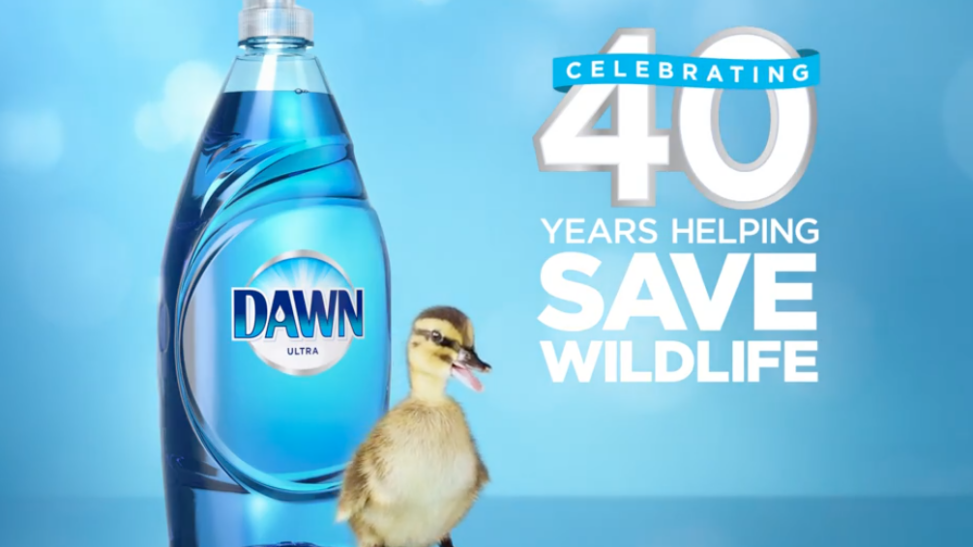Willow Reddy
VISA1500
Professor Terryl Atkins
January 29, 2024
Dawn dish soap is well known for their campaigns to save wildlife and fight against oil spills. The company reached forty years of “Helping Save Wildlife” in 2018 and released promotional ads starring their signature dawn dish soap and duck. The soap is seen as more environmentally friendly than its competitors as proceeds go towards the environment and it claims to be safe for animals. 1 The ad’s demographic would cover all those hoping to achieve a more sustainable eco-conscious life. The goal of this advertisement would be to expand the dish soap’s demographic and sell more products. Dawn dish soap while actively donating to environmental causes, is greenwashing.
The ad has a simple design with pastel blues in the background and a duckling in front of the dish soap bottle in the foreground. Bold white lettering calls attention to the campaign of saving wildlife. The ad conveys an environmentally conscious product with the small duckling and large text. The stark contrast between the blues of the background and the yellow duck makes the ad eye-catching and holds a consumer’s attention. Dawn as a company has donated roughly $4.5 million towards environmental causes 2 and is in collaboration with International Bird Rescue and the Marine Mammal Center.3 Dawn dish soap’s ad is direct and simple, showing their recognizable bottle with their activism in an easy-to-follow and understandable advertisement. Dawn dish soap however contains ingredients detrimental to wildlife. The chemical methylisothiazolinone and Chloroxylenol, both of which are found in dawn dish soap, were in a study to determine if they “[pose] a serious threat to ecosystems” (Nowak-Lange 2022, 1). 4 The study done in 2022 by a team of scientists in Korea found that “The results indicated that MIT[methylisothiazolinone] and PCMX[Chloroxylenol] at increasing concentrations inhibited the growth of bacteria. MIT appeared to be more toxic to the tested organisms than PCMX (Nowak-Lange 2022, 10).5 Both chemicals were found to be toxic and harmful when interacting with certain bacteria in the environment. Chemicals such as these can be harmful to our wildlife and completely contradict Dawn’s image of clean chemical products. These are not the only chemicals that were found toxic to the environment that are found in dawn dish soap. Triclosan 6 was a chemical found in Dawn dish soap that has “high toxicity”(Contardo-Jara 2021, 7).7 The chemical has since been banned in Canada and removed from Dawn products however it is important to note that Dawn Dish soap was aware of potential environmental risks and kept it in the product for many years before the ban8. The removal of Triclosan is a positive step towards an eco-friendly product however whether they removed it for environmental purposes or because it was banned is undetermined. The ad is misleading and contributes to greenwashing as it provides the illusion of being a safer choice for the environment while containing harmful chemicals.
The product is effective for its demographic. Most consumers will not closely analyze each ingredient and its negative effects. The label of saving wildlife would be effective in swaying a majority to buy this product in hopes of being more conscious of their environmental output. Dawn Dish Soap is also a well-known company with a loyal consumer base; this advertisement would expand this with its greenwashing and highlighting of the company’s donations. The companies’ donations however do not offset the negative impact their products have on the environment and marine life.
Work Cited
“10 Worst Household Products for Greenwashing | CBC News.” CBCnews, CBC/Radio Canada, 14 Sept. 2012, www.cbc.ca/news/canada/10-worst-household-products-for-greenwashing-1.1200620.
Contardo-Jara, Valeska, et al. “Fate, bioaccumulation and toxic effects of triclosan on a freshwater community – a mesocosm study.” Environmental Advances, vol. 5, Oct. 2021, p. 100100, https://doi.org/10.1016/j.envadv.2021.100100.
“Dawn Dish Soap Ingredients.” Dawn, dawn-dish.com/en-us/how-to/what-dawn-is-made-of-ingredients/. Accessed 29 Jan. 2024.
Nowak-Lange, Marta, et al. “In vitro study of the ecotoxicological risk of methylisothiazolinone and chloroxylenol towards soil bacteria.” Scientific Reports, vol. 12, no. 1, 9 Nov. 2022, https://doi.org/10.1038/s41598-022-22981-9.
“The World Needs More Wildlife Heroes.” Dawn Helps Save Wildlife | Dawn Dish Soap, dawn-dish.com/en-us/dawn-saves-wildlife/. Accessed 29 Jan. 2024.


Alex Fallowfield
I think the student did an excellent job conveying how Dawn as a company greenwashes with their products. The student thoroughly discussed how although Dawn heavily brands their ‘eco-friendliness,’ their dish soaps contain chemicals “Methylisothiazolinone and Chloroxylenol”. These chemicals are harmful to the growth of bacteria, which can cause chain effects throughout an ecosystem with serious consequence to our environment. The student also mentions how Dawn removed a “highly toxic chemical” called “Triclosan” from their dish soap after it was banned for commercial use in Canada. The student also illustrates the moral characteristics of the Dawn company, as they were aware of the harmful environmental effects of “Triclosan” long before it’s removal from their soap products.
This paper fits the criteria with use of at least 2 scholarly sources, both being recently published scientific papers. Among other sources, one being from CBC news and the other two coming directly from the Dawn company.
I think the student did a great job analyzing certain aspects of the advertisement, such as the advertisements use of vibrant contrasting colors, and identification of all the key elements that make up this advert. However, I would’ve liked a bit more detail put into the analysis of Dawn’s ‘mascot’ the duckling. I think some really good points could have been made about their decision to choose a duckling for a mascot to encompass all of ‘wildlife’. There seems to be some audience manipulation from Dawn by putting an adorable, defenseless little creature (that in the advertisement is about a quarter the size of the bottle,) and I would have preferred for that to be touched on more in the analysis.
Overall excellent work 🙂